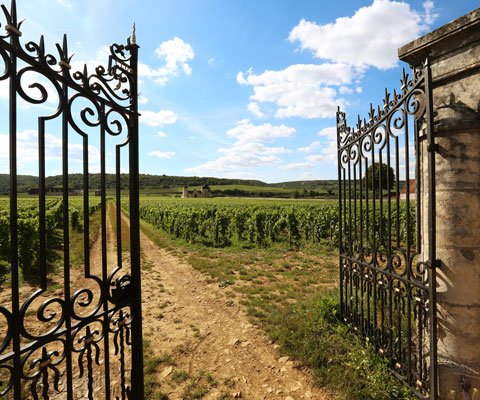Vézelay is a corner of white Burgundy unknown to most. Paolo Valdastri tells us about it, thanks to an unusual but very useful experience in approaching a distant wine region.
Perhaps Don Abbondio had better ideas about who Carneade was than the average Italian wine enthusiast does about where Vézelay is. Yet we are in Burgundy, one of the most famous wine regions in the world. But ” Vèzelay, who was he?” is also being asked by those who purchased the eighth edition of The World Atlas of Wine by Hugh Johnson and Jancis Robinson, as in, the world wine bible, one of the most comprehensive and prestigious books on wine. Well Vèzelay is not mentioned in the index. To find a trace of it, one must go to the general map of Burgundy, where the location of Vèzelien is found, near Avallon and Chablis, but without information or commentary.
In the 1995 edition of Burgundy by Antony Hanson (Faber and Faber, London) there is only a description of the Bernard Raveneau SICA La Vézelienne cooperative, ten growers in this wine district taking off. “Little help comes from INAO on the use of the Vézelay origin name to launch these unknown excellent wines“.
It takes until 1997 for Vézelay to receive official recognition as an appellation Aoc Bourgogne Vézelay and to 2017 as a “Village” appellation and only for white wines. It is the 44th Village appellation of Burgundy. Camillo Favaro and the late Giampaolo Gravina in. Wines and Lands of Burgundy., 2018, review a winery in Vézelay, La Croix Montjoie, “the range is centered on white wines and is essentially three labels selected on the basis of the different ripeness of the grapes and the different age of the vines, and not because of differences between climats. If you plan a trip to Burgundy…it would be a shame not to include a visit to the small village of Vézelay in the program .”
Let’s enter the denomination
Geographically we are in the northernmost part of Burgundy and can be reached by taking the road from Beaune to Chablis. In 2018 it had an Aoc area of 256 hectares of which 70.92 were in production in four villages-Vézelay, Asquins, Saint-Père, Thairoiseau. The following are currently operational 20 farms growing a single variety: chardonnay. Average annual production is 2,183 hl, about 290,000 bottles.
The vineyards of Vèzelay are situated on one bank and the other of the river Cure, a tributary of the Yonne. The presence of the vine is attested since Gallo-Roman times and had reached its apogee in the 18th century with 500 hectares under vine. Then phylloxera all but wiped out the vine until 1973 when it was revived by a handful of a dozen or so heroic winegrowers, led by Marc Meneau restaurateur of L’Esperance of Saint-Père-sous-Vézelay.
Why talk about Vézelay?
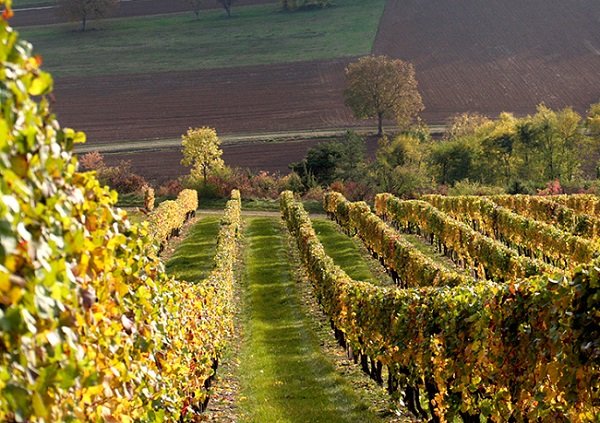
Why deal with a production area of only white wines, so little known in our market and almost unobtainable in most domestic wine shops?
The first reason concerns the sentence: “but ultimately the French have nothing to teach us.” The second reason is to look for an answer to the sentiment rooted in the small homegrown Docs: “nobody knows us! Why isn’t anyone ever talking about us?”. Mantras repeated to the point of boredom, but never finding the crux of the matter. Third and fundamental reason: the search for a good white Burgundy at a human price and consequently be able to make a meaningful comparison between our white productions and lesser-known foreign ones.
The occasion: one fine day I receive an invitation from the BIVB (Bureau Interprofessionnel des Vins de Bourgogne) to register for the seminar: “Rendez-vous avec les vins de Bourgogne, l’AOC Vézelay.” which includes an educational workshop and an online tasting. The online meeting includes a talk given by Robin Kick MW, interviews with producers and industry professionals, tasting of 6 wines thanks to the shipment of a tasting box with six 40ml samples. Intrigued, I immediately accepted the invitation.
The demonstration of professionalism: before the arrival of the samples, a commitment arises between my head and neck that I could not refuse. Displeased, I write to the BIVB saying that I am not sure I can attend and that they will therefore reserve the sampling for someone else. The reply was: “Merci pour nous avoir informés de votre empêchement. Si jamais vos engagements changent, n’hésitez pas à vous joindre à la présentation en live” . That is, we still send you the samples, you showed interest. And indeed I finally managed to get back on time to comfortably follow the whole program and here is the result.
The terroir
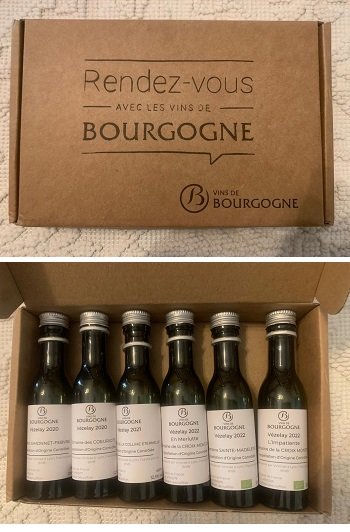 We mentioned theimportant presence of the Cure River, a tributary of the Yonne. The Cure valley is bordered on the west by a deeply indented slope with numerous parallel valleys, characterized by a succession of rocky spurs dominated by that of Vézelay. The vineyard faces south-southeast and lies between 190 and 330 meters above sea level. Climate data show an average annual temperature of 10.7°C, with an average annual precipitation of 732 mm. The subsoil consists of marl and limestone deposited over 15 million years during the Jurassic period, with characteristic heart-shaped fossil shells present. Differences between left and right banks are very often highlighted and correspond to two different soil and climate situations. The right bank to the east yields fruitier wines due to a prevailing southern, southeastern exposure while the left bank to the west is traversed by cool currents and offers decidedly vertical and saline wines.
We mentioned theimportant presence of the Cure River, a tributary of the Yonne. The Cure valley is bordered on the west by a deeply indented slope with numerous parallel valleys, characterized by a succession of rocky spurs dominated by that of Vézelay. The vineyard faces south-southeast and lies between 190 and 330 meters above sea level. Climate data show an average annual temperature of 10.7°C, with an average annual precipitation of 732 mm. The subsoil consists of marl and limestone deposited over 15 million years during the Jurassic period, with characteristic heart-shaped fossil shells present. Differences between left and right banks are very often highlighted and correspond to two different soil and climate situations. The right bank to the east yields fruitier wines due to a prevailing southern, southeastern exposure while the left bank to the west is traversed by cool currents and offers decidedly vertical and saline wines.
The tasting confirmed in full the expectations
Despite the differences between left bank and right bank, or between different maturation and aging distributed between stainless and oak, the style of these wines is well delineated. Great rigor in bringing out the terroir, with all efforts aimed at controlling in the vineyard the climatic difficulties inevitable in such a northern area, exposed to frosts and cool currents. Perhaps the current climate change will benefit this situation, reducing the annual criticality. We find linear wines with fresh aromas, fine vegetal traits, never invasive. The palate juggles sharp acidity and the structure is never yielding, the end result associating pleasantness and drinking agility to a solidity not trivially wide. Finally, the length is always fully adequate. The wines are certified organic or in conversion.
Prices refer to online availability. These are affordable prices, in most cases in line with those of the best known homegrown whites. In this case, in addition, you have the assurance that the amount paid corresponds to an appropriate style and sure quality and that in the end we will not be disappointed by the tasting.
On the pairing front, these are wines well suited to shellfish and seafood, fresh or hard goat cheeses. With oak intervention, they go well with poultry or white meats.
Details of the tasting are in the tabs below:
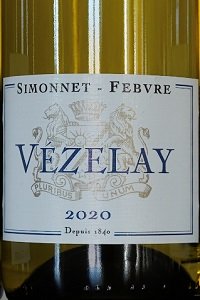 Vézelay 2020 Simonnet-Febvre
Vézelay 2020 Simonnet-Febvre
94 – € 18
100% Chardonnay. The company owns 64 ha of vineyards with clay and limestone soil. Average vineyard age 25 years. Stainless steel. Pale straw yellow. Intense aromas of cedar and mint, white fruits and hints of oyster shell. Savory, up to saline, fresh with nice non-aggressive acidity, has much in common with the Chablis style. A wine with a very linear style, good articulation and great pleasantness.
Alcohol content: 13% vol.
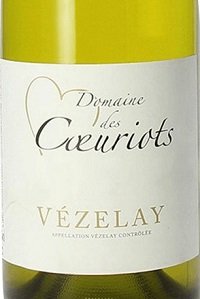 Vézelay 2020 Domaine Des Coeuriots
Vézelay 2020 Domaine Des Coeuriots
90 – 18€
100% Chardonnay from 9 ha under organic farming since 2021, located mostly on the left bank, a small part on the right bank in two plots. The name coeuriots recalls the heart-shaped fossils found in the clay-limestone soils of the vineyards. After fermentation it rests 9 to 12 months on the lees.
Bold straw yellow. On the nose a delicately smoky, flint note, then tropical fruit and light elderflower. The palate also repeats hints of fruit, mango and lime closure. Salty freshness offset by some fatness of fruit, a wine with fair complexity and good personality.
Alcohol content: 12.5% vol.
 Vézelay 2021 Vignerons de la Colline Eternelle
Vézelay 2021 Vignerons de la Colline Eternelle
89 – 17.50 €
100% Chardonnay from 20 ha of vines cultivated by 7 vignerons with respect for the environment, with manual harvests and reasoned farming. The vineyards are located on both banks and the Vézelay is a blend of the two different areas.
Brilliant straw yellow with green highlights. The nose has vegetal notes accompanied by tropical fruit, mango, melon, pineapple. It has a very delicate and light structure, but supported by vibrant acidity. An undemanding wine, but of great drinkability and pleasantness.
Alcohol content: 12.5% vol.
 Vézelay En Merlutte 2022 Domaine de la Croix Montjoie
Vézelay En Merlutte 2022 Domaine de la Croix Montjoie
93 – 20 €
100% Chardonnay from 15 ha of organically grown vines mainly on the right bank on a beautiful ridge in the village of Tharoiseau. Fermentation in steel then 9 months in 350 l used barrel.
Fairly intense straw yellow with golden hues. Alongside the white fruit there are notes of bread crust, brioche, always presents the iodine note. The palate is consistent with the aromas, has good alcohol presence and repeats the vanilla pastry scent while still sharpened by freshness and savoriness. The finish reveals good depth and exceptional length.
Alcohol content: 13%vol.
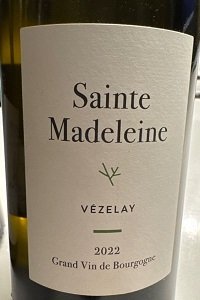 Vézelay 2022 Domaine Sainte Madeleine
Vézelay 2022 Domaine Sainte Madeleine
91 – 22€
100% Chardonnay from two plots on the right bank on Jurassic clay-limestone soil. Average age of the vines 34 years. The winery, established in 2020, is the latest created in this young appellation. Natural fermentation with indigenous yeasts and aging in steel.
Intense straw yellow. The nose reveals hints of flint and vegetal hints of bay leaves and honeysuckle accompanied by unripe white fruit, apple and pear. In the mouth it surprises with a vigorous structure, is soft and fresh with nice acid grip and great length. A fine expression of the right bank.
Alcohol content: 13% vol.
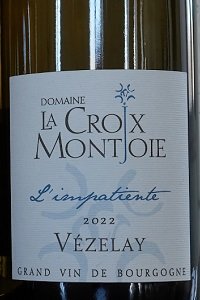 Vézelay L’Impatiente 2022 Domaine de la Croix Montjoie
Vézelay L’Impatiente 2022 Domaine de la Croix Montjoie
96 – 35 €
100% Chardonnay, organic. Fermentation and maturation for 9 months in stainless steel only. Deep straw yellow. Compared to the Vèzelay En Merlutte, it is more buoyant, has more presence of fresh fruit, white flowers and a distinct saline and iodine note reminiscent of seaweed. In the mouth it is solid with nice ripe fruit dominating the profile, has nice savoriness and great length. A wine of great breed with a firm, linear character that relies entirely on terroir.
Alcohol content: 13.5% vol.





